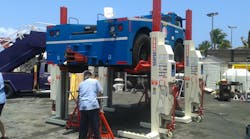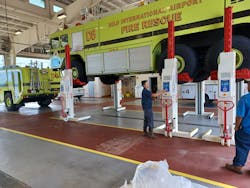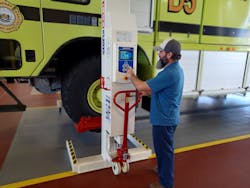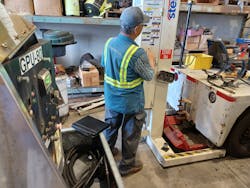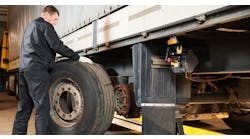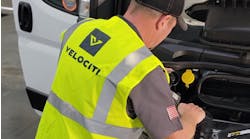In the early ’90s, equipment salesman Lou Cardoza’s children were grown and out of the house, making the California man and his wife empty nesters. Instead of flying south to enjoy their golden years, they made the 2,500-mile-long journey west to Hawaii’s Big Island, where they always dreamed of retiring. The dream location was achieved, but retirement was still financially out of reach for the couple, so Cardoza kept selling as an independent contractor.
Cardoza, now an exclusive seller for lift manufacturer Stertil-Koni in Hawaii—along with Guam, Saipan, and American Samoa—has one of the largest territories imaginable and by far the most sparsely populated.
“If you take all of the registered vehicles in Hawaii, Guam, Samoa, and Saipan and put them all together, it’s still much smaller than probably what’s registered in New York or Maryland,” Cardoza noted.
Technology has allowed Cardoza to be a less frequent flyer. He used to make quarterly visits to Guam, a 4,000-mile trip, which required a nine-hour flight. Now, most of the sales and training to those far-off tropical territories are done virtually.
His customer base is also vast, serving a range of fleet customers from Class 8 trucks and tour buses to airport, military, and municipal units.
When he first arrived to the Rainbow State, Cardoza solely worked for a Japanese equipment manufacturer, but then he expanded to covering 40 automotive product lines. Cardoza soon discovered his customers on the islands lacked something mainland shops may take for granted: vehicle lifts. And he decided in 1998 to go exclusive with his best-selling brand, Stertil-Koni. He also held onto his Pro Cut International account. Pro Cut, a division of Snap-On Inc., sells brake lathes, which have become more popular with trucking fleets as they adopt air disc brakes.
“Ninety percent of the accounts I called on had no vehicle lifts,” Cardoza recalled of his early days. “They were doing all their service on creepers, literally crawling along the ground—not a particularly safe or efficient practice.”
Improving shop efficiency is of even higher value on an isolated mound of cooled lava, when every resource is rare, from labor to parts to land. Lifts can increase the one controllable resource: time.
“If they do a PM in the air versus on the ground, timewise, it’s 80% less time,” Cardoza said. These PMs can range from oil changes to brake and wheel maintenance. “They can then remove the wheels, the brake drums, and so forth with our high-lift wheeled dolly.”
Lifts also protect employees from losing time and companies from paying for workplace-related injuries
“A lift improves technicians’ proficiency and their well-being,” Cardoza said. “It’ll reduce workmen’s compensation because they’re not developing back problems from getting under a vehicle.”
See also: Stertil-Koni partners with historic Culver City to lift its heavy-duty fleetAnd likely because of Cardoza’s longevity and tenacity in the region, Stertil-Koni’s reach has greatly increased. The best seller by far has been the Maryland-based lift manufacturer’s line of mobile column lifts, which can be arranged by one person in multiple configurations. These include wireless mobile column lifts, cabled mobile column lifts, and EARTHLIFTs.
Hawaii has some of the priciest land in the U.S., a reason the pineapple and sugar farms are no longer viable. Shops that serve a small customer base that doesn’t travel far (the longest trucking route is 100 miles) must use their space economically as well. That’s why Cardoza estimated that 90% of his customers choose mobile lifts.
“Mobile column lifts are adaptable to all applications,” Cardoza explained. “They can be moved from point A to point B and so forth. The customers like them because of their mobility and all the factors that go along with them.”
Some larger customers, such as the City of Honolulu, also use Steril-Koni’s Skylift and aboveground four-post lifts, though those cost more overall due to changing the infrastructure. Honolulu County purchased 16 mobile column units, along with six flush-mounted Skylifts.
“Sometimes that’s impossible because the landlord, or the lease, won’t allow them to dig up the concrete,” Cardoza said. “Mobile columns are more economical based on those facts.”
Cardoza doesn’t have to spend much time setting up the shops, as unboxing and training take about an hour total. He noted the wheels on the lifts have the ability to withstand all the capacity to lift and won’t damage the surface beneath them, whether that is concrete, asphalt, or another hard surface.
The wireless mobile lifts use a military signal called Zigbee to connect the independent columns, which need to be in perfect synchronization to prevent a vehicle from tipping off the lift.
“A lot of times you’re lifting vehicles—a waste truck, for example—that have unequal weight distribution between the front and rear axles,” said Paul Feldman, Stertil-Koni’s director of marketing. “The mobile lift automatically adjusts for that.”
Feldman added the mobile column lifts come with touchscreen controls to make operation easier. Former “Tonight Show” host and prodigious car collector Jay Leno has one in one of his garages.
They are powered by marine batteries, with ratings of 18,500 lb., 22,000 lb., or 40,000 lb. per column. The battery lasts about 35 lift cycles and will need to be replaced between three and five years. Maintenance is minimal, with hydraulic flushes needed every two years.
A truck with a dual-drive axle may need six columns, while a fire-fighting water truck at the airport would use eight. A pickup would likely only need two, one in front and one behind.
The lifts come with an extra wide set of forks to accommodate wider, larger tires.
Air lift
Those attachments come in handy at Hawaiian Airlines’ various sites across Hawaii’s main islands, including Oahu, Maui, and Kauai, explained Curtis Balingit, Hawaiian Airlines’ senior manager of the ground service equipment department. These include smaller 6,000-lb. baggage tugs to 65,000-lb. pushback tractors and fuel haulers, which the airlines’ technicians have serviced with Stertil-Koni’s mobile lifts for about a decade. There are five stations currently using the mobile lifts, according to Balingit.
“It makes more sense for the guys to stand up and easily work on the heavy tractors instead of having to crouch down,” Balingit said. “There is a much older gentleman who doesn’t like to bend down. He uses the Stertil-Koni lift so he can work on forklifts’ brakes and tires.”
At the nine-bay Honolulu site, Balingit’s crew performs PMs, unscheduled work, and fabrications for various custom units, and that versatility calls for flexibility of the equipment. Because the mobile columns can be configured for each type of vehicle and at various bays, the lifts have fit right in.
“We like their ability to easily move around the shop, and we can lift pretty much anything at any location,” Balingit explained.
There’s also a drive-on Challenger system rated up to 18,000 lb. in the shop for brake, transmission, and axle work, but Balingtit did not want to add any extra fixed lifts, which would tie up more space and become trip hazards.
Cords are also trip hazards, which is another reason Balingit favors the wireless battery-operated lifts. They can recharge overnight.
In terms of safety, Hawaiian Airlines reinforces lifted equipment with additional jackstands.
“Just in case we lose tire pressure on one of the units while it’s on at height, we don’t want this thing to come crashing down, so we put support stands on all the units that we lift,” Balingit said.
Recently, Balingit noticed the columns were too far apart and supervised the adjustment of them to ensure that if a tire did go flat, the rim would not fall through and damage the chassis.
“That would make for a catastrophic event because that thing would definitely tip off of the lift and could fall to the ground,” Balingit asserted. “You want to make sure that the unit is picking up the tire as close as possible to the forks—you don’t want any gaps. When you’re lifting a vehicle, you want it to be lifting up equally.”
Maintenance on the airline’s shop equipment was not needed during the COVID-19 pandemic, as Hawaii saw a sharp decline in tourism because of the lockdowns. No flights in or out meant the vehicles did not require as much maintenance. But now things are nearing normal again, and Balingit and other fleets on the island have Cardoza to arrange help.
Cardoza has a repair tech well-versed in swapping batteries, changing fluids, and fixing any other issue.
“We do have to check periodically to make sure they’re in in spec,” Balingit said. “And there were a couple of times when we needed some repairs because something wasn’t working, but Lou is really good about getting those concerns addressed and back in operation for us.”
